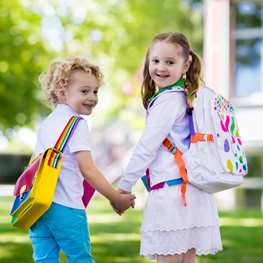
The Good Old Days: I began teaching first grade back in the dark ages: the decade of the 1960s. Back then, many children didn’t attend Kindergarten, and those who did spent their days at play stations where they painted, dressed up, pretended to cook meals, and built tall walls with blocks. Their day was rounded out with story times, a snack, and a nap.
In my first grade classrooms, we started from ‘the very beginning.’ Children learned the alphabet and their numbers in the Fall of first grade. Many of them learned color recognition and how to cut with scissors. First grade was truly their first learning experience. By Spring, most of them were reading well and doing simple math problems. No one was in a hurry to push for mastery of skills in the first grade.
Today’s academics
In today’s more academic environment, much of the creative play and art activity has moved down to preschool classrooms or daycares, and children are expected to dive into reading and writing in Kindergarten from day one.
Parents may feel the pressure of greater responsibility to introduce learning in the home. In our fast-paced culture with (typically) both parents working outside of the home, there may not seem to be enough hours in the day. The result? Parents feel stressed over the possibility their child isn’t ready for the rigors of classroom learning.
An overview of readiness skills
Readiness for learning is more than just what a child can do with a pencil and paper. There are four basic readiness areas and corresponding entry-level expectations to help you see where to bolster skills or possibly help you determine that another year of growth and preparation would be beneficial for your little learner.
It’s a wise family that is willing to give their child the necessary time to prepare for the rigors of classroom learning to ensure optimal success later. And, as most educators will tell you, boys often benefit from beginning their school years when they’re a little older and can focus and attend at a higher level.
As you scan through the following skills, ask yourself if your child is well-prepared in each area. If not, you can add extra support at home. Young children are very adaptable. They learn new skills quickly when they’re introduced in a positive manner. Even a few weeks of practice on a certain skill will produce good results.
Social Readiness: Does your child…
Building emotional skills takes time and practice. Give your child simple chores to build responsibility. Give simple directions and support your child in completing the task. Talk about ways to get along with others and give reminders when necessary. Provide proper instruction for hygiene skills.
Reading/Writing Readiness: Does your child…
Reading and writing skills are extremely important to learning. Your child should hear stories read aloud every day and take part in the process at an ever-increasing rate. Ask questions as you read. Have your child make predictions and see if they were right. Point out simple words and talk about unique words in the text. Allow a child to retell a story in their own words.
Provide lots of writing supplies. Pictures will evolve into approximated letter shapes. Standard writing will soon follow.
Physical Readiness: Does your child…
Materials to help grow physical skills related to learning include crayons, markers, pencils, glue, scissors, paper and paints, puzzles, building toys, such as Legos, and blocks.
Encourage your child to run and play outdoors. Playing ball, using playground equipment, and doing other outdoor physical activities will build their physical skills.
Math Readiness: Does your child…
Math skills can be done orally. Count the animals you see while riding in the car. Count how many blueberries there are in the bowl. Simple games such as matching and sorting games build math concepts. Supplies, such as magnetic numbers, and objects, such as small plastic toys for counting, all contribute to building math skills.
Jan Pierce, M.Ed., is a retired teacher and reading specialist. She is the author of Homegrown Readers and Homegrown Family Fun. Find her at janpierce.net.
Calgary’s Child Magazine © 2024 Calgary’s Child